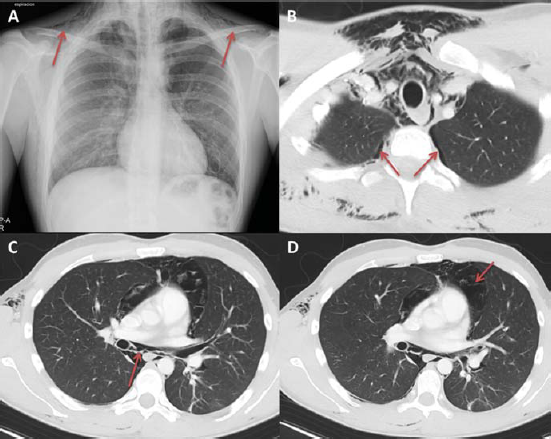Translate this page into:
Macklin effect: Spontaneous pneumomediastinum caused by marijuana
[To cite: Segura-Méndez B, Fuentes-Martín A, Soro-García J. Macklin effect: Spontaneous pneumomediastinum caused by marijuana. Natl Med J India 2024;37:231. DOI: 10.25259/NMJI_95_2023]

- A. Chest X-ray: bilateral subcutaneous emphysema (arrows); B. CT scan: small bilateral pneumothorax (<10%) (arrows); C. CT scan: emphysema with peribronchial space dissection (arrow); D. CT scan: emphysema with dissection of paracardiac space (arrow)
A 19-year-old man marijuana user (7–8 times/day) was admitted for subcutaneous emphysema, dyspnoea and pleuritic pain. He presented with emphysema in the right hemithorax and cervical region with pain on palpation and with marked dissection of the right pectoral muscle fibres on X-ray. CT scan showed small bilateral pneumothorax (<10%), bronchovascular mediastinal emphysema and bilateral paracardiac emphysema with extension to cervical spaces, without perforation of the thoracic or abdominal viscera.
He was admitted for monitoring and remained haemodynamically and respiratory stable throughout his stay. The pneumothorax and pneumomediastinum resolved without requiring thoracic drainage. He was discharged on the third day of admission with outpatient follow-up.
Spontaneous pneumomediastinum is infrequent, more common in young men, manifesting with dyspnoea, pain and subcutaneous emphysema. Marijuana is a substance being increasingly used, for both, recreational and medical reasons. Inhalation of marijuana is associated with respiratory symptoms such as chronic cough, increased secretions, dyspnoea and hoarseness, and is a risk factor for pulmonary bullae and secondary pneumothorax. The mechanism may be inhalation manoeuvres, chemical toxicity or induction of cyclic vomiting. Increased alveolar pressure and rupture of the alveolar wall causes dissection of perivascular and peribronchial spaces and is called the Macklin effect, which can be achieved through the Muller or Valsalva manoeuvre. Generally, the course is self-limiting and benign, and does not require intervention. It is important to know the history of illegal substance use in this pathology, especially in young patients.
Conflicts of interest
None declared




